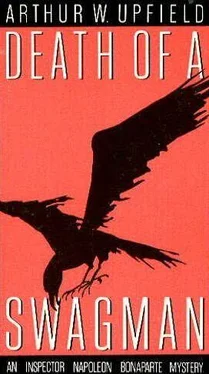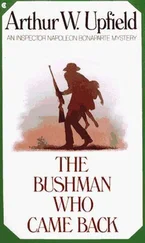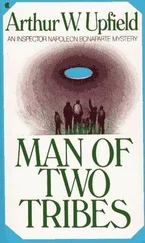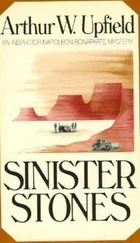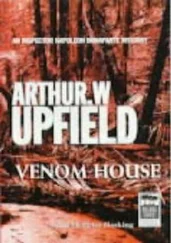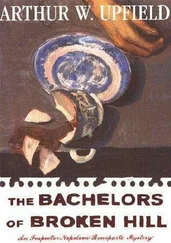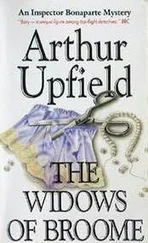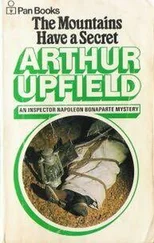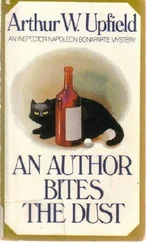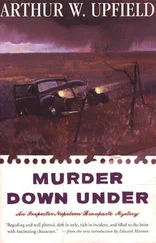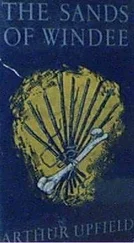Arthur Upfield - Death of a Swagman
Здесь есть возможность читать онлайн «Arthur Upfield - Death of a Swagman» весь текст электронной книги совершенно бесплатно (целиком полную версию без сокращений). В некоторых случаях можно слушать аудио, скачать через торрент в формате fb2 и присутствует краткое содержание. Жанр: Классический детектив, на английском языке. Описание произведения, (предисловие) а так же отзывы посетителей доступны на портале библиотеки ЛибКат.
- Название:Death of a Swagman
- Автор:
- Жанр:
- Год:неизвестен
- ISBN:нет данных
- Рейтинг книги:4 / 5. Голосов: 1
-
Избранное:Добавить в избранное
- Отзывы:
-
Ваша оценка:
- 80
- 1
- 2
- 3
- 4
- 5
Death of a Swagman: краткое содержание, описание и аннотация
Предлагаем к чтению аннотацию, описание, краткое содержание или предисловие (зависит от того, что написал сам автор книги «Death of a Swagman»). Если вы не нашли необходимую информацию о книге — напишите в комментариях, мы постараемся отыскать её.
Death of a Swagman — читать онлайн бесплатно полную книгу (весь текст) целиком
Ниже представлен текст книги, разбитый по страницам. Система сохранения места последней прочитанной страницы, позволяет с удобством читать онлайн бесплатно книгу «Death of a Swagman», без необходимости каждый раз заново искать на чём Вы остановились. Поставьте закладку, и сможете в любой момент перейти на страницу, на которой закончили чтение.
Интервал:
Закладка:
There followed a period of silence which Marshall did not find to his liking. His long career as a policeman in the interior of Australia had made himau fait with the growing problem of the half-caste and the half-caste’s problems. He knew that they were invariably intelligent, and that it was their white fathers who were degraded and not their black mothers, members of what was originally one of the most moral races that ever walked this earth. He was aware, too, that these people were mentally capable of competing successfully with the white man-were they but given the chance.
“Kendall was killed and the bush concealed the tracks of his murderer from you and Redman and any other white man and black man who might try to wrest the secret from the bush. But it will not baffle me, because I am neither wholly black nor white. I have the white man’s reasoning powers and the black man’s eyesight and knowledge of the bush. The bush will give up its secrets tome.-I believe that someone is calling for you.”
The sergeant stood up. Both men heard the rapid footsteps approaching the lockup. Then Constable Gleeson appeared at the door.
“Mrs Fanning is over at the office, Sergeant,” he said. “She states that she went over to her father’s hut to take him a roasted joint and that he is lying on the floor. She says that there is blood on the floor under his head, and she thinks he is dead.”
“We’ll go along, Gleeson,” Marshall said, astonishingly unruffled. He turned to Bony, to see him with his two hands together and the finger tips touching his chin. He looked quite happy.
Chapter Three
The Book of the Bush
WHEN Edward Bennett was found dead in his hut on the outskirts of Merino he was in his eighty-second year. In life he had looked but sixty, in death, according to the Merino undertaker, he looked-well, not peaceful.
He had retired from hard work at the age of seventy. His wife was dead. His only daughter, married to the Merino butcher, had said to her willing husband: “Father must come and live with us.” Old Bennett had snorted: “Be hanged if I will. I’m living in me own house.”
Old Bennett had built himself a two-roomed hut on the eastern edge of Merino, some few hundred yards north of the hall, which stood on the lower left-hand corner of the street. It faced over the vast area of country falling gently away toward the Walls of China, which appeared to be much higher than actually they were; and it was, therefore, less than a quarter of a mile from the post office, where the ancient battler had drawn his old-age pension.
“I expected it,” the doctor was saying. “Told him he was liable to drop dead any minute, and advised him to listen to his daughter and go and live with her.”
Bony did not enter the hut with the policemen and the doctor. To him, of primary interest was this open page of the Book of the Bush awaiting hisreading. What had happened within the hut could be established by the three men who had entered it. What may have happened outside the hut no one of them could establish better thanhe.
The hut was built of four-gallon petrol tins cut open and nailed as sheets to the wood framework. The roof was of stouter corrugated iron. The building was enclosed by a brush-wood fence in which was only one low gate in the front. Inside the fence old Bennett had laid the rubble of termite nests, watered and tramped itlevel, and thereafter had kept it swept. It was almost cement-hard, and the tracks of no man would be registered upon it.
Outside the fence the ground was sandy and in places rippled like the sand left by the receding tide. From the gate the sandy path wound away towards the hall, which it skirted to gain the street, and on it were the old man’s tracks and those of his daughter, who was wearing rubber-soled canvas shoes.
No two persons walk alike. The gait of every human being varies from normal to when he is sick, and again when his mind is controlled by strong emotion. An aboriginal, on seeing the imprint of a naked foot, will seldom fail to name the owner of the foot that made it.
Following a request put forward by Bony, the police party had proceeded to the hut away from the path, and Bony, who walked after the three men, had automatically observed their boot prints on the ground. Until this case was concluded he would not fail to recognize the tracks made by those three men, as well as those made by Mrs Fanning, any more than he would fail to recognize their faces.
Marshall wore boots size nine. He walked with greater pressure on the back of his heels than elsewhere, and the toes were almost in alignment with the heels. The heel pressure denoted a man who had received rigorous training. The doctor’s toes were placed outward a little more than that of the average white man, and the greatest pressure was at the extreme tip of the toes, denoting an eager, easily excited mind. His stride was much shorter than that of the sergeant, indicating that he was a short man or fat. In point of fact he was shortish and tubby. Gleeson placed his toes slightly inward, with greatest pressure on the inside of the soles. His boot print could have been made by any stockman accustomed to much horse riding, but the regularity of his stride and directness of his walk indicated a man trained in a military camp-in his case the police barracks. His boot size was seven: the doctor’s size was eight.
The dead man’s tracks were on the path beside which were the holes made by the point of his stick. His tracks were all about the outside of the fence, to and from the wood heap and the office. There were, too, the tracks made by a heavy dog from the right forepaw of which a toenail was missing, and those made by alighterweight dog. At present there was only one dog barking from beyond the wood heap. There were the tracks made by the feet of two white children whose visit had been made at the shortest two days previously.
Bony walked over to the wood heap to visit the dog.
It was a kelpie. She greeted him vociferously, straining at her chain at his approach, and inviting him with impatience to loose her. She was the lightweight dog, obviously owned by old Bennett, and there was no need to examine her right forepaw to find all the nails were there. The dog minus the toenail was probably a town dog.
Bony returned to the path by skirting the rear of the hut. He made a second tour, the hut forming the hub, he the rim of the wheel fifty yards out from the hub. Now he was walking on his toes, his body bent slightly forward, his head hunched between his shoulders and his face tilted downward, his blue eyes never still as they surveyed that narrow section of the Book of the Bush over which he passed. And when almost opposite the gate, he read a sentence on this page of the book which immediately aroused his interest.
As has been stated, the hut faced towards the east across three miles of open country falling gently to the foot of the Walls of China. Here and there were giant redclaypans, hard as cement and separated by narrow ridges of loose sand. Old man saltbush were scattered about the scene, and widely spaced water gutters, now dry, zigzagged slightly to the north-east to join a dry creek bordered by box-trees.
What aroused Bony’s interest was a peculiar mark made on a sand ridge separating twoclaypans. It was not distinct and the depression was very slight, but those keen blue eyes could see the crisscross lines forming a patch in symmetrical pattern. The mark had been made by hessian sacking, but the sack itself was not to be seen, and no human tracks were there to prove how the sack had been removed.
Now walking quickly, he followed the edge of the claypan round to its opposite side, where the sand ridge was only a foot wide, separating it from another and larger claypan. He traversed the edge of this one, and on its far side came to a wider stretch of sand. There in five places he saw the mark of the sack. Still there was no sign of the sack itself, but beside the sack marks were the imprints of the dog having a toenail missing. The dog had come from the creek to the north-east.
Читать дальшеИнтервал:
Закладка:
Похожие книги на «Death of a Swagman»
Представляем Вашему вниманию похожие книги на «Death of a Swagman» списком для выбора. Мы отобрали схожую по названию и смыслу литературу в надежде предоставить читателям больше вариантов отыскать новые, интересные, ещё непрочитанные произведения.
Обсуждение, отзывы о книге «Death of a Swagman» и просто собственные мнения читателей. Оставьте ваши комментарии, напишите, что Вы думаете о произведении, его смысле или главных героях. Укажите что конкретно понравилось, а что нет, и почему Вы так считаете.
